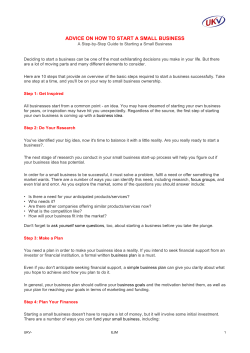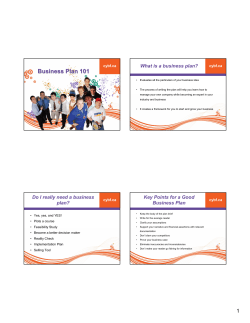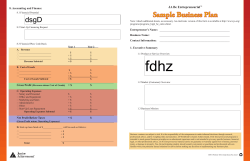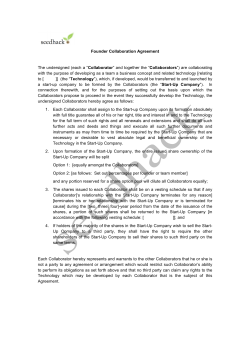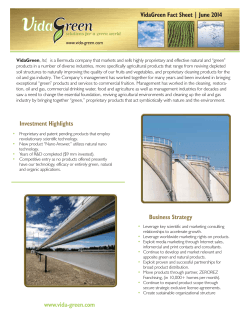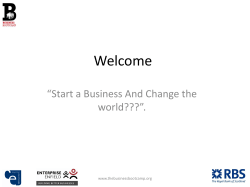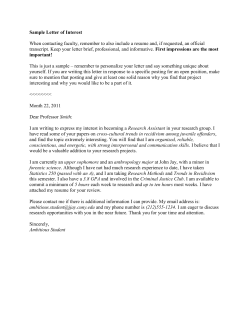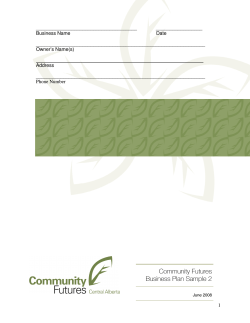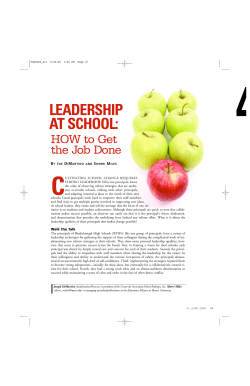
BUSINESS PLAN OUTLINE Prepared by: Stephen Gizzi, Esq.
BUSINESS PLAN OUTLINE Prepared by: Stephen Gizzi, Esq. Gizzi & Reep, LLP Benicia, CA (707) 748 0900 www.SolanoLawGroup.com THOSE WHO FAIL TO PLAN; PLAN TO FAIL SIMPLE BUSINESS PLAN FORMAT 1 1) EXECUTIVE SUMMARY 2) TABLE OF CONTENTS 3) MISSION STATEMENT 4) OWNERSHIP AND COMPANY LEGAL STRUCTURE / REQUIREMENTS 5) DESCRIPTION OF PRODUCTS AND/OR SERVICES 6) TARGET MARKET ANALYSIS 7) COMPETITIVE ANALYSIS 8) MARKETING STRATEGY 9) OPERATIONAL ANALYSIS 10) PERSONNEL / ORGANIZATIONAL CHART 11) FACILITIES 12) EQUIPMENT 13) KEY CONTACTS 14) FINANCIAL INFORMATION, PROJECTIONS AND BUDGETS 15) TIMETABLE 16) RESUME' OF PRINCIPALS AND KEY EMPLOYEES 1 PLEASE NOTE: This Outline is intended to be in a generic format, and therefore adaptable for manufacturing, product or service businesses. 1) EXECUTIVE SUMMARY Write this section last. Use it to tell the reader what you’re about to tell them. Highlight the major points of the business plan. No more than three paragraphs. Provide the following information: o Name of the company o Name of key managers o If you’re requesting financing: Briefly describe financing need Outline the proposed repayment plan List any secondary source of repayment The objective of the Executive Summary is to provide enough information to pique the reader's interest and motivate them to read the entire plan. At the same time, it is important not to provide so much information that reading the entire plan becomes unnecessary. 2) TABLE OF CONTENTS A table of contents which lists both the major and sub-categories of your plan should be included. In addition, identify and describe the contents of any exhibits that are attached to your business plan. 3) MISSION STATEMENT A Mission Statement is a formal declaration that summarizes the entrepreneur's business "destination" and the reasons why the company is in business. Specifically, a mission statement: Provides vision, inspiration and motivation; Is a way for the business to obtain and maintain focus, particularly when there are difficult decisions to be made; Gives a sense of purpose and identity; Can be referred to when strategies are being developed and Most importantly serves as the "reality check". Typically, a Mission Statement is no longer than a sentence or two and consists of less than 25 words. The statement usually begins with the phrase: The mission of (company name) is............... The statement goes on to describe the "utopian" objectives of the company, and what is important to it, in general terms. For example, one company's statement read: "The mission of duPont is to provide better things for better living through chemistry". Another service business' statement: "Our mission is to provide innovative and responsive services, with professionalism and integrity, in an atmosphere of enthusiastic teamwork which promotes employee development and mutually beneficial business relationships". Try writing one for your company. Start by identifying single words that represent issues that are important to you personally, as they apply to your company. Now combine these key components into a comprehensive, cohesive statement. _________________________________________________________________ _________________________________________________________________ _________________________________________________________________ _________________________________________________________________ _________________________________________________________________ _________________________________________________________________ 4) OWNERSHIP AND COMPANY LEGAL STRUCTURE / REQUIREMENTS In this section, list all of the principals of the company and their percentage of ownership interest, the legal structure (i.e. sole proprietorship, partnership, S-corporation, C-corporation or LLC) of the company and its domain. Indicate what each principal's role is in the company. List the name and job title for each or indicate if they are only a silent partner or investor. Specify which are serving as an officer or director of the corporation (if applicable). If you are buying an existing business or practice, discuss the age of the business, prior ownership and any other pertinent data relative to the prior operation. If you’re purchasing a franchise or licensed territory, include information about the franchisor or licensor. Provide a list of any licenses, permits, approvals or registrations which are required to operate your business, and other material information including: City zoning compliance, variances and/or use permits required Local licensing criteria Local fire department, public works, planning clearances State licenses, occupational licenses or permits, professional registrations Federal tax identification number Employment Development Department registration County fictitious name registration State Board of Equalization permit and any required bonds County Department of Health permit (restaurants, certain manufacturers, etc.) County Environmental Health permit OSHA approvals / clearances of safety plans, etc. DOT,BAR,CHP requirements 5) DESCRIPTION OF PRODUCTS AND/OR SERVICES If you are a manufacturer, briefly discuss the product manufacturing process. List each product and service, or category of products and services – areas of specialty Where applicable: o Identify what inventory levels will be maintained; o Name the primary suppliers; o Discuss when you have exclusive sales or distribution rights; o Estimate the frequency and amount of inventory purchases; o Highlight significant product factoids such as: Unique features Competitive advantages (Exclusive Distribution Contracts) Distribution systems o Discuss product expansion opportunities. If the company has intellectual property, trade secrets or proprietary information: o Generally describe why the particular asset represents value to the company without disclosing anything that compromises its proprietary nature. o List any patents, trademarks or copyrights held by the company or its principals. o Give an overview of steps taken to protect intellectual property and proprietary assets of the company. 6) TARGET MARKET ANALYSIS Define your target market geographically and develop a customer profile: Develop a demographic profile (age, sex, income, family size, occupation, lifestyle, etc.) of the prospective customers in your target market area? Will you have wholesale customers? [FOR LAW FIRM – EXAMPLE would be insurance company or other source for ongoing flow of business at reduced hourly rate] What are the common characteristics of your customers? How many potential customers do you estimate are in your target area? How frequently will they purchase from you? Are there enough transactions for you to build your business? (Estimate the total annual $ spent by your target audience) Is your business going to be seasonal? How "price-sensitive" is your target market? Can your products or services be expanded to meet other needs of the same target market group? [ i.e., Does today’s contract review client need other business services? / Family law clients almost always are potential estate planning clients postdissolution, etc. ] The more you learn about your potential customers, the more likely you are to be able to identify the most successful methods for reaching them and turning them into long-term, loyal customers who will purchase additional products and services. 7) COMPETITIVE ANALYSIS List the names of at least 3 companies, firms or individuals that you believe represent the most serious competition in your target market area and address the following: What will be your competitive advantages? o Briefly describe how any intellectual property or unique features of your company will provide a competitive advantage. What will be your competitive disadvantages? How will you mitigate them? How do your competitors compete? How will you compete (i.e. in what areas)? [i.e., what do you want to be known for? ] Some possible categories to compete in are: Price Service Image Sales Methodology Hours of Operation Convenience Quality Reliability Reputation Credit/Payment Policy Efficiency Size Selection Expertise Facilities Ethics Location 8) MARKETING STRATEGY You’ve now identified: 1) what you're going to sell; 2) to whom you're going to sell and 3) who else is selling to the same target group. In this section, indicate how you intend to communicate your message to your clients in a way that will be meaningful and cost-effective. Discuss your marketing budget and calendar distribution2. REMEMBER! (1) SALES AND MARKETING ARE NOT THE SAME THING….AND… (2) ADVERTISING IS NOT MARKETING…AND MARKETING IS NOT ADVERTISING, though advertising is ONE component of marketing. MARKETING is the broad category encompassing everything that you do to promote your business. Describe in detail your general marketing plan. Be sure to indicate the feedback methods (sourcing) that will be utilized to monitor and measure the success of your program. Identify specific media or other promotional opportunities and their approximate monthly cost. Establish goals that are relevant to your business. (i.e. how much does it cost to bring in a customer through a direct mail program? through newspapers? per Google hit? etc.) Discuss active and passive marketing programs that you intend to use. Detail your anticipated web presence. What sort of company web site will you maintain? Set goals for monthly number of web visits, time spent per page and follow up inquiries from your site. Will you have a presence on the major social media sites and, if so, how will they be maintained? Will you have a blog? Will you join local industry and non-industry organizations, business and networking groups and service clubs? What criteria will you use to determine if your marketing efforts are successful? Cost per phone inquiry? Per customer walk-in? Per sale? 9) OPERATIONAL ANALYSIS Under this category provide a general outline of how the business will be run on a day-to-day basis. For example (where applicable): What will be the business' hours of operation? What are the support staff needs? Who will handle the accounting, payroll or other professional service needs? What steps have been taken to protect your intellectual property, trade secrets and proprietary information? What types and levels of insurance will be carried and by whom? What personnel systems and policies are in place? Will they be in writing? What will be the "inside" marketing program and sales strategy? 2 If your business is seasonal consider allocating marketing dollars accordingly rather than a set amount per month. Estimate the number of clients to be serviced each day. 10) PERSONNEL / ORGANIZATIONAL CHART Prepare an organizational chart for the business. List each separate job category even if you anticipate initially fulfilling each of the jobs yourself. Remember, one of the purposes of a business plan is to posture your business for growth. Anticipating future staff requirements now will ensure a smooth transition as the need arises. List the names of each key employee and employee category and provide the following: Title and a brief job description General background, Relevant Qualifications and amount of relevant prior experience required Position Training requirements If you will be hiring a large labor force, list the categories of all employment positions and the median salary levels and benefits package, and the number of employees for each. Discuss: Anticipated recruitment and hiring criteria Seasonal or weather considerations Part time or temporary employees Independent contractors, consultants etc. Outline the general employment terms: Employment at-will Non-Disclosure policies Noncompete Agreements Harassment Policies Confidentiality agreements Indicate the presence, or lack thereof, of any handbooks, operations manuals or policy and procedure documents which are provided to employees. What training programs will new employees be required to participate in? What, if any, ongoing safety programs will be required? 11) FACILITIES Provide the address of the business location and a detailed outline of the physical plant or facilities that the business will occupy. Give a breakdown of the total square footage by category (i.e. office, manufacturing, garage, yard space, etc.) and provide a floor plan. Summarize the terms of the rental, lease or purchase agreement and the company's total premises-related financial obligations. Describe the surrounding neighborhood, the current zoning, the proximity to freeway or major artery access and signage. Is there adequate parking? Discuss any potential size limitations of the property (how much can the company grow before it will need to move or expand the facility?) and any features and benefits of the premises which make it a good location for the business. 12) EQUIPMENT Describe the major equipment utilized in your business. For each specify its use within the business, capacities, age and estimated remaining useful life, present value, ownership status (leased, owned) and the amount of any loans, liens or other encumbrances. List any major office equipment such as computers or networks and any significant or proprietary software, other significant office machines, telecommunications systems, etc. that will be utilized. 13) KEY CONTACTS Most businesses have certain individuals both within and outside of their industry that play a significant role, both directly and indirectly, in the success of the business. Included among these are the business' banker, independent consultants, industry or civic leaders, customer representatives, buyers, key suppliers, etc. Providing a list of these gives a sense that there is an outside connection and support network for the business. 14) FINANCIAL INFORMATION, PROJECTIONS AND BUDGETS If applicable, describe what computer software program is used for the daily and periodic accounting. The financial section should include, at minimum, the following financial reports broken down by month: A start-up balance sheet with an itemized break down of capital equipment A capital expense budget for one year A projected income statement and budget for one year that lists all sales, expense and budget categories. Fixed and variable expenses should be listed separately. A projected cash flow statement for a minimum one year period. A break-even analysis for the business Sales forecasts broken down by product or service category for one year. A personal budget for one year which indicates how the business owner will fund personal financial needs during the start-up phase of the business.3 In addition, state the source of your funds and their anticipated use (capital equipment, leasehold improvements, inventory, working capital, etc.). If you are buying an existing business or franchise, provide a minimum of the most recent two years financial statements. 3 This should be excluded from distributed copies of the Business Plan except when the plan is used in conjunction with requests for financing. 15) TIMETABLE For business startups, compile a list of all projects or activities that must be completed prior to the start-up of the business. For each, describe the activity, name the person responsible for its completion, list the start date and completion date and estimate any associated costs. If you are unsure of the exact start-up date of the business, list project start-up and completion dates in relative terms, for example: SU -90 days, SU - 30 days, etc. SAMPLE: TASK -90 LOCATE FACILITY FINALIZE LEASE SET UP FINANCIALS FINALIZE LOANS CREATE WEBSITE RECEIVE INITIAL INVENTORY ORDER PRINTING HIRE & TRAIN EMPLOYEES INITIAL ADVERTISING “SOFT” OPENING FORMAL GRAND OPENING X -60 -45 -30 -15 START UP + 30 X X X X X X X X X X 16) RESUME' OF PRINCIPALS AND KEY EMPLOYEES The final section of your business plan should include a resume' for each principal which lists all previous employment or business experience, educational background, awards, recognitions or appointments and personal references. Note: Also provide a resume' for each key management employee that will have significant responsibility within the organization. Now………… ENJoY YoUR SUCCESS!!!
© Copyright 2025
